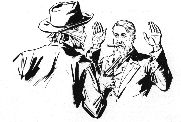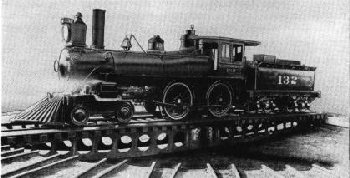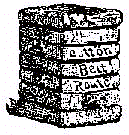Cotton Belt - Believe it or NOT !
Changing the gauge in 24 hrs

The officers of the road realized that they were not only without financial backing, but that it was necessary for them to standard-gauge the road and build branches to add to the traffic of the system while the territory was being developed. Fordyce believed that by changing the gauge and building new branches he might be able to operate without any outside financial aid. It was decided that when tie replacements were necessary, a longer one would be installed, and the outside spike driven in at the right place in order to save time on the appointed day. Cars and engines were changed, and on October 18, 1886, at a prearranged hour, traffic was suspended, and the reinforced section gangs completed the change over the northern division in twenty-four hours. The work of changing the gauge on the Texas lines was completed January 12, 1887. Changing the gauge cost close to 513 million--a staggering sum in those days. Over 1'//2 million cross ties were used which cost an average of 29c each (in 1957 the average cost was $3.17 each). The second part of the rehabilitation program was the acquisition or construction of branch lines to tap the communities adjacent to the main line. The branches in Arkansas were built through the medium of separate corporations to satisfy provisions of the Arkansas laws. Before any construction work was done, these companies sold their rights and franchises to the St. Louis, Arkansas and Texas Railway Company in Arkansas and Missouri, which then built the lines.

Fordyce and the Bandit

The president's business car rolled north from Texarkana, carrying Colonel Samuel W. Fordyce and directors of the Cotton Belt on their annual inspection tour of the road. It was almost dark as the train stopped at Red River bridge to wait for the drawbridge. Inside the car the directors were enjoying their after-dinner cigars as they discussed the fine trip they had had thus far. Suddenly the discussion was cut short when a shot rang out ahead of the special train. Colonel Fordyce stepped out onto the platform and found himself face to face with a masked man who pointed a pistol in the Colonel's face and told him to get back in the car. The Colonel retreated, followed by the masked gunman. As the Colonel backed into the lighted room, the masked man looked startled--he seemed to recognize Colonel Fordyce. At the same time Colonel Fordyce recognized that voice. The bandit was an old friend of the Colonel's named Shang Doland. Shang had been a freight conductor when the Colonel was station agent back in Ohio before the Civil War. Shang had turned up in Hot Springs, while Colonel Fordyce was living there, and the Colonel had found him a job on the police force. Later Shang killed a man and was sent to the penitentiary at Little Rock. After he had served a short time, Colonel Fordyce obtained a pardon for his colorful friend.
Colonel Fordyce said: "Shang, aren't you ashamed of yourself to come over on the Cotton Belt and try to rob a road as poor as this one? Don't you know that no one with any money ever rides on the Cotton Belt? Why don't you go over and hold up the Iron Mountain?" The bandit was floored; he pulled off his mask and extended his hand, saying: "Excuse me, Colonel, if I had known this was your special, I never would have held it up. I'll go out and stop the boys and let you go. Good-bye."
Shang took the Colonel's advice, and a few nights later he and his boys held up a northbound Iron Mountain train out of Texarkana. A few weeks later the Colonel received a keg of moonshine liquor by express, along with a note from Shang saying that while he and his boys were hiding out in the hills they had come upon a still and the liquor was so fine he wanted the Colonel to have some of it. In his memoirs, Colonel Fordyce added in his characteristic manner: "I took great delight later on in giving United States Judge Caldwell some of it and then told him that the revenue tax had never been paid on it."

Engine 132 falls into the Red River
In 1887, engine number 132 went into the Red River when a bridge it was crossing gave way. The engineer and fireman jumped for their lives as the engine sank into the water, and both swam ashore unhurt. The engine remained in the river several years, until a wrecking crew raised it, moving it to Pine Bluff shops on its own wheels. Seven days later, this same engine pulled a full train to Texarkana, and remained on the main line until it was replaced by heavier locomotives.
The 4-4-0 Locomotive 132 after being raised from the Red River in 1887
One week after being raised, it was back in service

Cotton Belt - FIRST in:
- First in the Southwest to use OIL as Locomotive fuel
- First to organize a sanitary engineering department to improve health conditions
- First to feature coordinated train-truck service
- First to give shippers passenger-train freight schedules
- First to offer consignees progress reports of freight en route

The decade preceding World War II witnessed a worldwide economic depression which had a marked effect upon the railroad industry. In spite of the severe restrictions imposed by financial conditions, the American railroads managed to modernize and improve their services in order to continue to serve the traffic demands of the nation. The Cotton Belt took its place with other progressive railroads in an effort to provide better rail transportation. In 1931 a fast merchandise train known as the "Blue Streak" was inaugurated, operating from St. Louis to Pine Bluff, Arkansas, with connections for Louisiana and Texas points. Its inauguration was coincidental with the establishment of free pickup and delivery service in the Southwest. Coordinated with the operation of the Southwestern Transportation Company, the "Blue Streak" provides overnight delivery from St. Louis to points along the Cotton Belt as far as Pine Bluff, a distance of some 400 miles, and 24-hour delivery to all Cotton Belt points, as well as to connecting lines.
The BSM was inaugurated in 1931 and was regarded as the
"Worlds Fastest Freight Train"


This Cotton Bale was the first Cotton Belt Logo but was changed because it gave the impression that Cotton Belt only hauled Cotton
In 1922 Twenty freight locomotives, each weighing 441,900 pounds, built by the Baldwin Locomotive Works for Southern Pacific were moved in a solid train from East St. Louis, Illinois, to Corsicana, Texas. The train was appropriately called the "Prosperity Special" (30K JPEG File) in the hope the name would symbolize happy days ahead. The twenty-locomotive train is shown at Illmo, Missouri, as it crossed the Mississippi River on the Thebes Bridge.
 Roundhouse (Home Page)
Roundhouse (Home Page)
History of Cotton Belt
Cotton Belt Dieselized 1950 - 1996
wbeck@email.com
This page hosted by
 Get your own Free Home Page
Get your own Free Home Page








